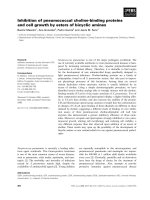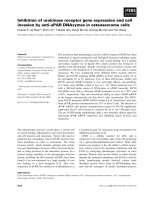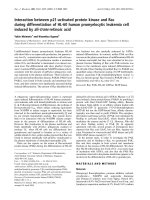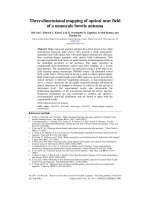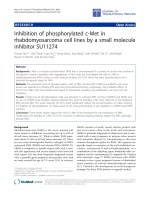Modulation of dorsal hippocampus field CA1 pyramidal cell excitability by an ascending relay from hypothalamic supramammillary nucleus
Bạn đang xem bản rút gọn của tài liệu. Xem và tải ngay bản đầy đủ của tài liệu tại đây (2.01 MB, 163 trang )
MODULATION OF DORSAL HIPPOCAMPUS FIELD CA1
PYRAMIDAL CELL EXCITABILITY BY AN ASCENDING RELAY
FROM HYPOTHALAMIC SUPRAMAMMILLARY NUCLEUS
JIANG FENGLI
A THESIS SUBMITTED FOR
THE DEGREE OF DOCTOR OF PHILOSOPHY
DEPARTMENT OF PHYSIOLOGY
NATIONAL UNIVERSITY OF SINGAPORE
2
00
4
ACKNOWLEDGEMENTS
This research work was carried out at the Department of Physiology, National University of
Singapore. I would like to express my deepest and sincerest gratitude to my supervisor,
Associate Professor Sanjay Khanna, for his patient guidance and suggestions, criticisms, and
friendly encouragement throughout the course of my Ph.D training.
I also express my thanks to Ms. Esther Chang, Senior Laboratory Officer, for the technical
support provided.
Finally, I am forever indebted to my parents and my wife for their understanding, endless
patience and encouragement during my difficult moments.
i
TABLE OF CONTENTS
TITLE PAGE
i
ACKNOWLEGEMENTS
ii
TABLE OF CONTENTS
v
LIST OF FIGURES
vii
LIST OF ABBREVIATIONS
ix
LIST OF PUBLICATIONS
x
SUMMARY
1
CHAPTER I INTRODUCTION
1.1 General morphology
2
1.2 Intrahippocampal circuitry
10
1.3 Physiological characteristics of hippocampal neurons
14
1.4 CA1 neural network activity-theta rhythm
23
1.5 Ascending regulation of hippocampal field CA1 neural activity
27
1.5.1 Medial septum-vertical limb of diagonal band of Broca (MS-VLDBB) region
28
1.5.2 Posterior hypothalamus-supramammillary (PH-SUM) region
34
39
1.6 Functional significance of theta in field CA1
1.7 Rationale and purpose of study
41
43
CHAPTER II MATERIALS AND METHODS
ii
2.1 Animals and general surgical procedure
44
2.2 Electrophysiological recordings, electrical stimulation and drug microinjection
44
2.3 Experimental protocols
45
2.3.1 Effect of electrical stimulation of the region of reticular pontis oralis nucleus
(RPO)
48
2.3.2 Effect of microinjection of procaine and gamma aminobutyric acid (GABA) in the
PH-SUM region
49
2.3.3 Effect of microinjection of carbachol (carbamylcholine chloride) into the PH-SUM
region
51
2.3.4 Effect of microinjection of procaine into the MS-VLDBB region
52
53
2.4 Histology
2.5 Data analysis
54
CHAPTER III RESULTS
58
59
3.1 RPO (reticular) stimulation
3.1.1 Effect of RPO stimulation on CA1 pyramidal cell excitability
59
3.1.2 Relationship of reticularly-elicited suppression to generation of theta
63
3.1.3 Effect of procaine microinjection in PH-SUM or MS-VLDBB region on
reticularly-elicited suppression vs. theta generation
64
3.1.4 Effect of PH-SUM region GABA on RPO-elicited suppression vs. theta
generation
74
3.1.5 Control experiments
84
iii
3.2 Chemical stimulation with carbachol microinjection
86
3.2.1 Effects of carbachol microinjection on CA1 pyramidal cell excitability
86
3.2.2 Spatial analysis of the effect of carbachol microinjection on CA1 pyramidal cell
excitability
98
3.2.3 Relationship of carbachol-elicited suppression to generation of theta
105
3.2.4 Comparison of strength of suppression evoked with microinjection of carbachol
vs. reticular stimulation
107
3.2.5 Effect of microinjection of procaine in the MS-VLDBB region on
carbachol-induced suppression
108
3.2.6 Effects of atropine on carbachol vs. pinch-induced suppression and theta activation
114
CHAPTER IV DISCUSSION
119
4.1 Findings of present study
120
4.2 Stimulation intensity-dependent effect of RPO stimulation on CA1 pyramidal cell
excitability
121
123
4.3 SUM and MS-VLDBB regions mediate suppression of CA1 excitability
4.4 Distinct neural elements modulate the suppression vs. theta activation
126
4.5 Cholinergic mechanisms in SUM mediate CA1 suppression
128
4.6 Possible neuronal type that underlies suppression
132
4.7 Functional significance of the present findings
134
REFERENCES
136
iv
LIST OF FIGURES
4
Fig. 1.1: The rat hippocampal formation: location, subdivision and cytoarchitecture
Fig. 2.1: The experimental protocols
47
Fig. 3.1: Reticular stimulation intensity-dependent effects on hippocampal
electroencephalogram (EEG) and CA1 pyramidal cell excitability
61
Fig. 3.2: Diagrammatic representation of procaine microinjection sites in the PH-SUM and
MS-VLDBB regions
66
Fig. 3.3: The time course of the effect of procaine microinjected in the ipsilateral medial
forebrain bundle (MFB)-supramammillary (SUM) region on reticular
stimulation-elicited responses
68
Fig. 3.4: Effect of procaine in the PH-SUM region on reticularly-elicited suppression of
dendritic field excitatory postsynaptic potential (dfEPSP)
69
Fig. 3.5: The lack of effect of procaine microinjected in dorsal/contralateral regions on
reticular stimulation-elicited responses
70
Fig. 3.6: The time course of the effect of procaine microinjected in the MS-VLDBB region
on reticular stimulation-elicited responses
71
Fig. 3.7: Diagrammatic representation of the GABA microinjection sites in the PH-SUM
region
76
Fig. 3.8: The effect of microinjection of GABA on reticular stimulation-elicited
responses
78
Fig. 3.9: The time course of the effect of microinjection of GABA into the SUM region on
reticular stimulation-elicited responses
80
Fig. 3.10: Lack of effect of microinjection of dye solution on RPO-elicited suppression of
population spike and theta activation
85
Fig. 3.11: Diagrammatic representation of carbachol microinjection sites associated with
suppression of CA1 population spike
88
Fig. 3.12: Diagrammatic representation of sites where microinjection of carbachol or dye
solution did not induce a suppression of the population spike
90
Fig. 3.13: Illustration of the carbachol-induced suppression of CA1 pyramidal cell
population spike that is attenuated by inactivation of the MS-VLDBB region
91
v
Fig. 3.14: The time course of suppression of CA1 population spike and theta activation
following microinjection of carbachol into the SUM region
93
Fig. 3.15: The peak suppression, latency to suppression of population spike, theta peak
power, theta peak frequency and latency to theta activation following
microinjection of carbachol into the SUM region
95
Fig. 3.16: Decrease of the CA1 population spike and the corresponding somatic field
excitatory postsynaptic potentials (sfEPSP) following carbachol microinjection
into the supramammillary region
97
Fig. 3.17: Comparable effect of carbachol (0.854- and 3.42-mM) microinjected into
ipsilateral vs. contralateral medial SUM region
100
Fig. 3.18: The time course of suppression of CA1 population spike amplitude and theta
activation following microinjection of carbachol (0.1 µl of 0.0285 mM) into
medial vs. lateral SUM region
101
Fig. 3.19: The time course of suppression of CA1 population spike amplitude and theta
activation following microinjection of carbachol (0.0285 mM) into the regions
immediately adjacent to the SUM region
102
Fig. 3.20: Lack of effect of microinjection of carbachol (0.1 µl, 0.0285-mM) in the region
dorsal or ventral from SUM on population spike amplitude and theta activation
103
Fig. 3.21: Comparison of the reticularly-elicited vs. carbachol-induced suppression of
population spike
109
Fig. 3.22: Diagrammatic representation of procaine microinjection sites in the MS-VLDBB
region
110
Fig. 3.23: The time course of the effect of procaine (0.5 µl, 20% w/v) microinjection into the
MS-VLDBB region on carbachol (0.1 µl, 0.854 mM)-induced responses
112
Fig. 3.24: Lack of effect of procaine microinjected outside the MS-VLDBB region on
carbachol-induced suppression of population spike
115
Fig. 3.25: Atropine attenuated carbachol- but not tail pinch-induced population spike
suppression and theta activation
117
Fig. 4.1: Schematic representation of the proposed ascending pathways from the SUM
region that are involved in the suppression of CA1 pyramidal cell excitability
130
vi
LIST OF ABBREVIATIONS
CA
cornu ammonis
CHAT
choline acetyltransferase
CSD
current source density
dendritic field excitatory postsynaptic potential
dfEPSP
electroencephalogram
EEG
excitatory postsynaptic current
EPSC
excitatory postsynaptic potential
EPSP
fEPSP
field excitatory postsynaptic potential
FFT
fast Fourier Transform
Fr
fasciculus retroflexus
GABA
gamma aminobutyric acid
hertz
Hz
i.p.
intraperitoneal
kg
kilogram
LDT
laterodorsal tegmental nucleus
LTP
long-term potentiation
lSUM
lateral supramammillary region
MB
mammillary body
vii
MFB
medial forebrain bundle
mg
milligram
mm
millimeter
min
minute
ml
milliliter
microgram
µg
microliter
µl
mSUM
medial supramammillary region
ms
millisecond
mV
millivolt
MS-VLDBB
medial septum-vertical limb of diagonal band of Broca
PH
posterior hypothalamus
PS
population spike
PPT
pedunculopontine tegmental nucleus
RSA
rhythmic slow activity
RPO
reticular pontis oralis nucleus
somatic field excitatory postsynaptic potential
sfEPSP
SUM
supramammillary region
SUMX
supramammillary decussation
viii
LIST OF PUBLICATIONS
1.
Jiang, F. and Khanna, S. (2004) Reticular stimulation evokes suppression of CA1
synaptic responses and generation of theta through separate mechanisms. Eur. J.
Neurosci. 19(2): 295-308.
2.
Khanna, S., Chang, L.S., Jiang, F. and Koh, H.C. (2004) Nociception-driven
decreased induction of Fos protein in ventral hippocampus field CA1 of the rat. Brain
Res. 1004(1-2): 167-176.
3. Jiang, F. and Khanna, S. (in preparation) Cholinergic mechanisms in
supramammillary region mediate suppression of CA1 pyramidal cell synaptic
excitability.
ABSTRACTS
1. Jiang, F., Khanna, S. and H. Wong, P.T. (2001) Effect of posterior hypothalamic
microinjection of procaine on hippocampal nociceptive responses. Society for
Neuroscience’s 31
st
Annul Meeting. Prog#: 280.9, November 10-15, San Diego, CA,
USA.
2. Jiang, F. and Khanna, S. (2002) Ascending relay mediating hippocampal nociceptive
responses. 1
st
NNI-NUS Neuroscience Symposium. D-2, March 14-16, Singapore.
ix
SUMMARY
Reticular stimulation-induced hippocampal theta involves a relay to the hippocampus via the
posterior hypothalamus-supramammillary (PH-SUM) region and then the medial
septum-vertical limb of diagonal band of Broca (MS-VLDBB). Interestingly, sensory- or
behavior-induced theta is accompanied by suppression of hippocampal field CA1 synaptic
responses. Given the links between theta activity and synaptic responses in CA1, it was
hypothesized that the theta generating stimulation, such as that of the region of the reticular
pontis oralis (RPO) nucleus (or reticular stimulation) will evoke a suppression of CA1 synaptic
excitability that is mediated via a neural relay involving the PH-SUM and the MS-VLDBB
regions. Additionally, the role of the PH-SUM region in regulating CA1 excitability was
assessed with direct chemical stimulation of the region.
The experiments were performed on urethane anaesthetized rats. Reticular stimulation induced
a suppression of the CA1 pyramidal cell population spike and the corresponding dendritic field
excitatory postsynaptic potential evoked by field CA3 stimulation. However, this suppression
was observed at stimulation intensity below the threshold for generation of CA1 theta and was
maximal at the threshold for theta. The frequency and amplitude of theta waves, by contrast,
increased further with increasing reticular stimulation voltage. The foregoing suggested that
mechanisms underlying reticularly-elicited suppression and generation of theta were
dissociated.
Neural inactivation by microinjection of the local anaesthetic procaine (20%w/v, 0.1-0.2 µl) or
the inhibitory ligand gamma aminobutyric acid (0.8 M, 0.5 µl) in the PH-SUM, especially the
x
ipsilateral medial SUM region, or the MS-VLDBB region, attenuated both suppression and theta
generation. However, and as with effect of reticular stimulation, the effects of microinjection on
suppression and theta were not always in parallel. In this regards: (1) the effect of inactivation of
medial SUM and the medial forebrain bundle (MFB; a fibre bundle with brainstem/diencephalic
afferents travelling to the hippocampal formation) on reticularly-elicited population spike (PS)
suppression preceded the loss of theta rhythm; (2) microinjection of procaine into MS-VLDBB
region, especially in the lateral regions, attenuated suppression with no apparent loss of theta; (3)
while the onset of effect of MS-VLDBB procaine on suppression paralleled the decrease in
amplitude of RPO elicited theta, the population spike suppression recovered to control even
though the amplitude of theta remained strongly reduced; and (4) the recovery of PS
suppression from microinjection of GABA in the medial SUM region preceded the recovery of
theta amplitude. Put together, the above suggests that separate neural elements in close
anatomical proximity to theta-related neurons in SUM and MS-VLDBB regions mediate
reticularly-elicited suppression.
Consistent with the notion that separate neural elements, at least in part, mediate CA1
suppression, the effect of microinjection of GABA on RPO elicited PS suppression was
observed from relatively fewer sites as compared to the effect of the agent on theta activation. In
this context, microinjections into the medial SUM region attenuated both PS suppression and
theta activation, whereas microinjection into the lateral SUM region and lateral-ventral sites in
PH did not affect suppression although the RPO elicited theta amplitude was reduced. Similarly,
microinjection into the MFB did not affect suppression. The lack of effect of GABA from lateral
SUM and MFB regions contrasts with the robust attenuation of suppression following procaine
microinjection at these sites. The foregoing pattern of effect with GABA is compatible with the
xi
view that the influence of SUM GABA on CA1 suppression is due to a selective affect of the
agent on synaptic transmission in the medial region. Perhaps, the medially positioned neurons
send their axons laterally to join MFB which might explain, at least in part, the efficacy of lateral
microinjection of procaine on suppression.
To further investigate whether neuronal mechanism in the SUM region mediate CA1 pyramidal
cell suppression, the medial or leteral region of SUM was chemically excited with local
microinjection of the cholinergic agonist, carbachol (carbamoylcholine chloride). Results
indicated that carbachol microinjected at concentrations of 0.0285-, 0.854- or 3.42-mM evoked
concentration–dependent suppression of CA1 population spike. As with RPO stimulation, the
carbachol-induced suppression of CA1 pyramidal cell excitability was accompanied by decrease
in the slope of the corresponding somatic field excitatory postsynaptic potential. The
carbachol-induced suppression of CA1 pyramidal cell excitability was antagonized by
systemically administrated cholinergic-muscarinic antagonist, atropine (5 mg/kg, i.p.), though
the antagonist did not antagonize the suppression and theta induced by tail pinch. Taken
together, the foregoing indicates that cholinergic mechanisms in the SUM region influence CA1
pyramidal cell excitability.
The suppression of CA1 population spike with microinjection of 0.0285 mM carbachol was
observed in absence of theta, whereas with the higher concentrations of carbachol the
suppression was accompanied by theta activation. While the maximal suppression evoked with
higher concentrations of carbachol was greater than the maximal suppression evoked on RPO
stimulation, the maximal RPO stimulation-evoked theta peak frequency and peak power was
significantly greater than that evoked at maximal suppression with the higher concentrations of
xii
carbachol. Both suppression and theta activation observed with microinjection of 0.854 mM
carbachol were reversibly attenuated by inactivation of the MS-VLDBB region with
microinjection of procaine, indicating that the suppression evoked by direct activation of SUM
was also mediated by the MS-VLDBB region.
On probing the PH-SUM region with the lower concentration of carbachol (0.0285 mM), it was
observed that the microinjection into the lateral SUM, but not medial SUM and PH evoked
robust suppression of PS at short latency. The medial SUM carbachol injections, as whole, were
ineffective in eliciting suppression. The greater potency of lateral injections in evoking
suppression is consistent with anatomical evidence of a large projection from the region to
MS-VLDBB.
Overall, the current study provides evidence that the SUM region mediates a decrease in
excitatory synaptic transmission at the apical dendrites of CA1 pyramidal cells via neural
mechanisms that are distinct, at least in part from those mediating CA1 theta activation. The
neural elements in SUM that mediate suppression include cholinoceptive neurons in the lateral
SUM region. The neural pathway from SUM involves the MS-VLDBB region in anatomical
overlap with the neural components underlying theta generation. The finding that the medial
SUM region is preferentially recruited on reticular stimulation, while a cholinergic agonist
affects lateral SUM region with greater potency, suggests the possibility that the SUM is
organized in a modular fashion in regulation of CA1 excitability. The activation of the
ascending inhibitory pathway(s) from SUM together with theta generation may provide a neural
basis for regulating hippocampal excitability during the theta functional state of the
hippocampus.
xiii
CHAPTER I INTRODUCTION
- 1 -
1.1 General morphology
The hippocampus (cornu ammonis or CA) is a three-layer allocortex, which is a part of
hippocampal formation (including hippocampus, dentate gyrus and subiculum). The
three-dimensional position of the rat hippocampal formation in the brain is rather
complex. It appears grossly as an elongated structure with its long axis extending in a
C-shaped fashion from the septal nuclei of the basal forebrain rostrodorsally, over and
behind the thalamus, to the incipient temporal lobe caudoventrally (Fig. 1.1A; Swanson
et al., 1978; Amaral and Witter, 1995). The long axis and orthogonal axis are referred to
as the septotemporal and transverse axis, respectively. The part of the hippocampus
lying above the thalamus is often called the dorsal hippocampus and the temporal part
the ventral hippocampus.
The pioneering work on the cytoarchitecture of the hippocampus was performed by
Ramón y Cajal (1893) and Lorente de Nó (1934), and has been reviewed and updated in
more recent review articles (Amaral and Witter, 1995; Freund and Buzsáki, 1996). The
description of the hippocampal cytoarchitecture given below is based on the foregoing
articles. It is notable that the cytoarchitecture has been derived using a variety of
techniques, including Weigert-Pal, Golgi or Cox preparation, and intracellular labeling
with dye.
The hippocampus has two major subfields, namely the fields CA1 and CA3 (Fig. 1.1B)
that differ in terms of the size of the principal (pyramidal) neurons and connections (see
below). Although Lorente de Nó (1934) also defined another hippocampal region,
namely field CA2, this area has not received any extensive attention and is ignored here.
- 2 -
Fig. 1.1: The rat hippocampal formation: location, subdivision and cytoarchitecture. A.
Three dimensional illustration of the hippocampal formation (hippocampus and the
dentate gyrus). Note the C-shaped structure of the hippocampal formation and its
position in the brain. The hippocampal formation extends from the basal forebrain, over
and behind the diencephalon (not shown here), to the temporal lobe. B. Nissl stained
coronal section through the dorsal hippocampus (rectangular panel in A), showing the
subfields of hippocampal formation. The two major subfields illustrated are CA1 and
CA3, while DG is the dentate gyrus. In the dorsal to ventral order in the coronal section,
the layers of the hippocampus-DG are the: alveus (a), stratum oriens (o), stratum
pyramidale (p), stratum radiatum (r), stratum lacunosum (l), stratum moleculare (m),
stratum granulosum (g), and hilus (or stratum polymorphe; h).
- 3 -
Fig. 1.1
A.
Hippocampal
formation
B.
a
p
o
r
l
m
g
h
- 4 -
In a dorsal to ventral order in the transverse section, the layers of the hippocampus-
dentate gyrus are the: alveus, stratum oriens, stratum pyramidale, stratum radiatum,
stratum lacunosum, stratum moleculare, stratum granulosum and stratum polymorphe
(Fig. 1.1B).
The alveus is a fiber bundle marking the outer boundary of the hippocampus. The
stratum oriens has number of interneuron type near the border with alveus and, in
addition, also contains basal dendrites and axon collateral from pyramidal cells. The
interneurons include (a) O-LM cells (interneuron with soma and dendrites in stratum
oriens, and axons in strata lacunosum-moleculare and oriens), which have an oval or
pyramidal shaped soma. The dendrites of these cells are either largely confined to
stratum oriens (in field CA1) or span all layers except stratum lacunosum-moleculare (in
field CA3). The axons of these neurons arborize in stratum lacunosum-moleculare
forming synapse with distal dendrites and spines of presumed pyramidal cells.
Occasionally, axonal branches are also directed towards stratum oriens, (b) bistratified
and horizontal trilaminar cells. The dendrites of bistratified cells are mostly radially
oriented and extend up to stratum radiatum, while the axon arborizes in stratum oriens
and in the proximal stratum radiatum forming synapse with proximal dendrites and
dendritic spine of pyramidal cells. The trilaminar cells posses either horizontal dendrites
running in stratum oriens or radial dendrites that can extend up to stratum lacunosum-
moleculare. The axon arbor of trilaminar cells is observed in three layers, namely
stratum oriens, stratum pyramidale and stratum radiatum, and (c) other types that include
interneurons that project across subfield boundaries and interneurons specialized to
innervate other interneurons. Basket cell interneurons that innervate the soma and
proximal dendrites may also be observed in the region (Klausberger et al., 2003).
- 5 -
The stratum pyramidale has 3-4 rows of the principal (pyramidal) cells. The pyramidal
cells of hippocampus along with the principal (granule) cells of the dentate gyrus make
up the bulk (~90%) of the cell population in the two regions (Olbricht and Braak, 1985).
The cell bodies of the pyramidal neurons are fusiform or ovoid. The soma of the
pyramidal cells in field CA1 is smaller as compared to those in field CA3. In CA1
region the pyramidal cells have a single apical dendritic tree that extends into stratum
radiatum. Several processes emit from apical dendrite in stratum radiatum. These
dendritic processes finally terminate in a tuft of thin branches in stratum lacunosum-
moleculare, and in most cases reach the hippocampal fissure. Basal dendrites from CA1
pyramidal cells are numerous. These arborize in stratum oriens and often reach the
alveus. The axon of pyramidal cells usually emerges from the region of soma adjacent
to the apical dendrite or occasionally from a basal dendrite before entering the alveus.
The pyramidal cells from CA3 give rise to one or two prominent apical dendrites usually
from the soma and often branch into large-diameter segments with proximately equal
size. The apical dendrites are radially oriented in strata radiatum and lacunosum-
moleculare, where they give rise to additional thin side branches that reach the
hippocampal fissure or the border of the hilus. The axons of CA3 pyramidal cells
usually arise from a primary basal dendrite or the lower pole of the soma. In addition to
pyramidal cells, population of interneurons is found with soma located within or
adjacent to stratum pyramidale. The first class of interneuron is basket cells. The
predominant dendritic morphology of basket cells in CA1 and CA3 is pyramidal-shaped
or bitufted. One or three dendrites originate from the apical pole of triangular or
fusiform soma and then branch and ascend through stratum radiatum, often penetrating
- 6 -
stratum lacunosum-moleculare. The primary basal dendrites also branch close to the
soma and proceed toward the alveus in a fan-like fashion, spanning the entire depth of
stratum oriens (Gulyás et al., 1993; Sik et al., 1995). The axon from the basket cell
extends transversely from the cell body and forms a basket plexus innervating the cell
body of pyramidal cells.
The second type of interneuron with cell body in stratum pyramidale or adjacent to it is
the chandelier (or axo-axonic) cells. These cells possess radially oriented dendrites
spanning all layers. The dendrites of chandelier cells rarely branch. Three to six main
dendritic trunks extend toward the hippocampal fissure. The basal dendrites in stratum
oriens extend up to, or occasionally penetrate the alveus. The axon of chandelier cells
originates from the soma or primary dendrites and forms a dense arbor in stratum
pyramidale and proximal oriens-usually 2 to 30 boutons arranged in rows parallel to the
axon initial segments of pyramidal cells (CA1 and CA3). Electron microscopy
demonstrated that these boutons selectively target axon initial segments of pyramidal
cells. In addition to basket cells and chandelier interneurons, bistratified interneurons
are also observed in this region (Bland et al., 2002).
Further ventral to stratum pyramidale is stratum radiatum. Stratum radiatum contains
apical dendrites mainly from pyramidal cells and, to a less extent from interneurons in
the stratum oriens and stratum pyramidale. Some interneurons with multipolar-stellate
like cell body are also found located in the stratum radiatum. The dendrite of this type
interneuron is smooth and varicose and forms a tree largely confined to stratum radiatum
(Freund and Buzáki, 1996). The axon branches close to the soma and forms a rather
- 7 -
sparse arbor which extends throughout the entire width of stratum radiatum. Only a
small number of collaterals enter stratum pyramidale or stratum oriens.
Stratum lacunosum consists of branches of apical dendrites of the pyramidal cells.
Interneurons are also found in stratum lacunosum. The cell bodies of these interneurons
are within stratum lacunosum or at the border of this layer with stratum radiatum. The
dendritic tree of these cells is typically bitufted with a predominantly horizontal
orientation as opposed to those from stratum pyramidale. Some branches extend into
stratum pyramidale and others even cross the hippocampal fissure and reach stratum
moleculare of DG. The axon from soma or proximal dendrites arborizes mainly in
stratum lacunosum and the border with stratum radiatum.
The stratum moleculare of dentate gyrus is mainly occupied by the dendrites of granule
cells, basket cells and various polymorphic cells as well as terminal axonal arbors from
several sources such as entorhinal cortex. Using intracellular recording combined with
dye injection in horizontal slice of the dentate gyrus of the rat, a type of neuron with its
cell body located in the deep stratum moleculare was found by Han et al. (1993). The
dendrite of this type of interneuron ascended to reach the hippocampal fissure and
spanned an area over 800 µm in transverse length. The axon of this type of cell ran
perpendicular to the granule cell dendrites and arborized in a terminal cloud. Since the
axonal and dendritic trees of this cell type are mostly confined to the outer two-third of
the dentate molecular layer, it was named molecular layer perforant path-associated cell
(MOPP cell). Electron microscopy revealed that axon terminals of this cell type
synapses with spiny distal dendrites of granule cells (Halasy and Somogyi, 1993).
- 8 -
Deeper to stratum moleculare is stratum granulosum. The granule cells (principal cells
of dentate gyrus) in this layer have a small elliptical cell body and form a densely
packed layer that is 4-8 soma in thickness. The granule cell has a characteristic cone-
shaped tree of spiny dendrites with all branches directed towards the superficial portion
of the molecular layer. The distal tips of the dendritic tree end just at the hippocampal
fissure or at the ventricular surface. The axon of granule cells originates at the opposite
pole of the soma and enters the adjacent polymorphic layer termed hilus. In the hilus the
axon branches into several local collaterals that largely remain in the hilar region
(Claiborne et al., 1986). Some collaterals course towards the granule cell layer, climb
along the cell bodies and synapse on basket cells interneuron in the granule cell layer.
The main axon of granule cell leaves the hilar region and courses towards CA3
pyramidal cell layer.
The principal cell of the hilus is the mossy cells. The cell bodies of the mossy cells are
large (25-35 µm), triangular or multipolar in shape. The dendrites of mossy cells are
typically confined to the hilar region, occasionally a dendrite also extends through the
granule cell layer and into molecular layer. The most distinctive feature of the mossy
cell is that all of the proximal dendrites are covered by very large and complex spines
that are the sites of termination of the dentate granule cell axons. The axons of mossy
cells terminate mainly on dendrites of granule cell at inner one-third of molecular layer.
Some mossy fiber collaterals also terminate on unidentified dentritic shafts in the hilus
and occasionally on dendrites of interneurons.
The cell body of chandelier and basket cells, with features similar to those described in
CA1 and CA3 region, are also observed within or adjacent to granule cell layer. The
- 9 -
axon from chandelier cells terminates on the initial segment of granule cells. The axon
from the basket cells emit a large number of collaterals, enter into the granule cell layer
and form dense pericellular arrays of synaptic boutons. Other interneurons that are
observed adjacent to the granule cell layer are the hilar perforant path associated cell
(HIPP) and hilar commissural-associational pathway related cell (HICAP).
1.2 Intrahippocampal circuitry
The intrahippocampal connections consist of prominent serial connections that include
those between the dentate granule cells and the hippocampal field CA3 as well as the
projection from CA3 neurons to field CA1. These connect the different regions in a
transverse and longitudinal plane. In addition, the neurons of the hippocampus and
dentate gyrus are also networked by longitudinal associational and commissural fiber
systems.
The axonal projection from the dentate granule cells to the field CA3 constitutes the
mossy fiber bundle. These axons are called mossy fibers because of their varicose
appearance that is similar to mossy fibers of the cerebellum (Ramon y Cajal). The
details of the mossy fiber system has been investigated in rat using variety of techniques
including (a) terminal and axonal degeneration following lesions in the dentate granule
cell layer (Blackstad et al., 1970; Gaarskjaer, 1978), (b) anterograde transport of tritiated
amino acids (Swanson et al., 1978), horseradish peroxidase (HRP; Claiborne et al., 1986)
or Phaseolus vulgaris leucoagglutinin (PHA-L; Amaral and Witter, 1989) and (c)
intracellular injection of HRP (Claiborne et al., 1986). The mossy fibers, which are
unmyelinated, travel in CA3 in a narrow band between the pyramidale cell layer and
- 10 -
below stratum radiatum in the region called stratum lucidum. Studies using Timm’s
preparation (Swanson et al., 1978) or electron microscopy (Blackstad and Kjaerheim,
1961) indicate that the mossy fiber varicosities make synaptic contacts with thorn-line
spine or dendritic shafts of the apical dendrites of pyramidal cells in field CA3.
Interestingly, the mossy fibers extend throughout the transverse extent of CA3 in a
lamellar fashion (Blackstad et al., 1970; Swanson et al., 1978; Amaral and Witter, 1989
and 1995). That is, the mossy fibers arising from granule cells at a septotemporal level
innervate a restricted septotemporal level of field CA3, though at the septal level the
mossy fibers near the field CA1 run caudally and parallel to the long axis of the
hippocampal formation for as much as 2 mm (Swanson et al., 1978).
The hilar collaterals arising from mossy axon have a number of varicosities which make
synaptic contacts upon dendrites of neurons in the polymorphic layer, including the
proximal dendrites of the mossy cells. These cells contribute to both associational and
commissural projection from the hilus to the inner third of the molecular layer of the
dentate gyrus (Claiborne et al., 1986; Amaral and Witter, 1995). The associational and
commissural projection from mossy cells is, at least in part, via collateral projections
(Swanson et al., 1981). The associational fibers from the hilus, both at septal and middle
levels, project to a considerable septotemporal extent of the dentate gyrus, though the
temporal hilus has a relatively restricted projection to the temporal dentate gyrus (Fricke
and Cowan, 1978; Swanson et al., 1978). Interestingly, the projection is relatively dense
away from point of origin (Amaral and Witter, 1995).
The axonal projection from CA3 pyramidal neurons that is intrinsic to the hippocampus
has been described using Golgi preparation, terminal degeneration, tracer transport and
- 11 -
